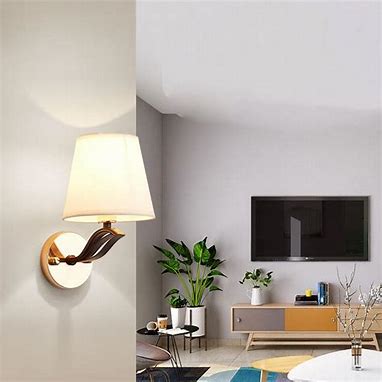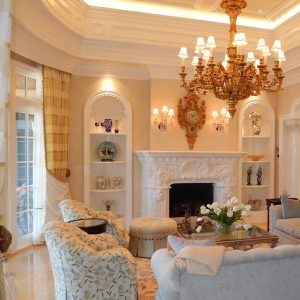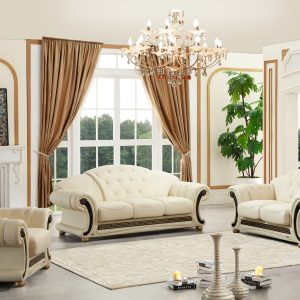Wall lamps have been a staple in interior design for centuries, and their timeless appeal continues to make them a popular choice for homeowners today. These elegant fixtures not only provide functional lighting but also add a touch of sophistication and style to any room. From their humble beginnings in ancient times to their modern-day adaptations, wall lamps have stood the test of time and remain a classic choice for lighting.
The history of wall lamps can be traced back to ancient civilizations such as Egypt and Greece, where they were used to illuminate homes and temples. These early versions were typically made of clay or metal and featured a simple design with a single light source. Over time, wall lamps evolved to include more intricate designs and materials such as crystal, glass, and brass.
Despite the advancements in lighting technology, classic wall lamps continue to be popular today. Their timeless appeal lies in their ability to seamlessly blend with any interior design style, from traditional to contemporary. Whether used as task lighting in a study or as ambient lighting in a living room, wall lamps add a touch of elegance and sophistication to any space.
The Versatility of Wall Lamps: Perfect for Any Room in Your Home
One of the greatest advantages of wall lamps is their versatility. They can be used in virtually any room in your home, from the bedroom to the bathroom, and everything in between. Here are some examples of rooms where wall lamps can be used:
1. Living Room: Wall lamps can be used to create a cozy and inviting atmosphere in your living room. They can be positioned on either side of a fireplace or above a sofa to provide soft, ambient lighting. Additionally, wall lamps with adjustable arms can be used to direct light towards specific areas, such as a reading nook or artwork.
2. Bedroom: Wall lamps are an excellent choice for bedside lighting in the bedroom. They free up valuable space on your nightstand and provide a soft, warm glow that is perfect for reading or relaxing before bed. Wall lamps with adjustable arms or swing arms are particularly useful in the bedroom, as they allow you to position the light exactly where you need it.
3. Bathroom: Wall lamps can be used to provide task lighting in the bathroom, particularly around the vanity area. They can be installed on either side of the mirror to eliminate shadows and provide even lighting for grooming and applying makeup. Wall lamps with frosted or opal glass shades are ideal for the bathroom, as they diffuse the light and create a soft, flattering glow.
In addition to their versatility, wall lamps offer several benefits over other types of lighting. Unlike floor lamps or table lamps, wall lamps do not take up valuable floor or surface space. This makes them an excellent choice for small rooms or spaces where clutter is a concern. Additionally, wall lamps can be hardwired into the wall, eliminating the need for unsightly cords and cables.
The Benefits of Using Wall Lamps: Functional and Decorative Lighting
Wall lamps offer both functional and decorative lighting, making them a versatile choice for any room in your home. Here are some of the benefits of using wall lamps:
1. Task Lighting: Wall lamps can provide focused, directional lighting that is perfect for tasks such as reading, studying, or working. They can be positioned at eye level to eliminate shadows and provide optimal lighting for these activities. Wall lamps with adjustable arms or swing arms are particularly useful for task lighting, as they allow you to position the light exactly where you need it.
2. Ambient Lighting: In addition to task lighting, wall lamps can also provide ambient lighting that creates a warm and inviting atmosphere. They can be used to illuminate dark corners or highlight architectural features such as artwork or bookshelves. Wall lamps with dimmer switches are ideal for ambient lighting, as they allow you to adjust the brightness to suit your mood or the occasion.
3. Decorative Lighting: Wall lamps are not just functional; they also add a decorative element to any room. With their elegant designs and beautiful finishes, wall lamps can enhance the overall decor and style of a space. Whether you choose a classic brass sconce or a modern glass fixture, wall lamps can become a focal point and conversation starter in your home.
Classic Wall Lamps: A Perfect Match for Any Interior Design Style
Classic wall lamps Homehubz are incredibly versatile and can complement any interior design style. Whether your home is traditional, contemporary, or somewhere in between, there is a wall lamp that will perfectly suit your aesthetic. Here are some examples of interior design styles that pair well with classic wall lamps:
1. Traditional: Classic wall lamps with ornate details and finishes such as brass or bronze are a perfect match for traditional interiors. They add a touch of elegance and sophistication to rooms with traditional furnishings and decor. Pair them with rich fabrics, antique furniture, and traditional artwork for a timeless look.
2. Contemporary: While classic wall lamps are often associated with traditional interiors, they can also work well in contemporary spaces. Opt for sleek, minimalist designs with clean lines and finishes such as chrome or brushed nickel. These modern interpretations of classic wall lamps will add a touch of sophistication to contemporary interiors without overpowering the overall design.
3. Transitional: Transitional interiors blend elements of both traditional and contemporary design, creating a harmonious balance between old and new. Classic wall lamps with simple yet elegant designs are an excellent choice for transitional spaces. Look for fixtures with clean lines, neutral finishes, and subtle details that bridge the gap between traditional and contemporary.
No matter what interior design style you prefer, classic wall lamps can add a touch of elegance and sophistication to any room. Their timeless appeal makes them a versatile choice that will stand the test of time.
How to Choose the Right Wall Lamp for Your Space: Tips and Considerations
Choosing the right wall lamp for your space can be a daunting task, but with a few tips and considerations, you can find the perfect fixture that complements your decor and provides the right amount of light. Here are some factors to consider when choosing a wall lamp:
1. Purpose: Before you start shopping for a wall lamp, consider the purpose it will serve in your space. Do you need task lighting for reading or working? Or are you looking for ambient lighting to create a warm and inviting atmosphere? Determining the purpose of the wall lamp will help you narrow down your options and choose the right type of fixture.
2. Size: The size of the wall lamp is an important consideration, as it should be proportionate to the size of the room and other furnishings. A small wall lamp may get lost in a large room, while a large wall lamp may overwhelm a small space. Measure the available wall space and consider the scale of other elements in the room to determine the appropriate size for your wall lamp.
3. Style: The style of the wall lamp should complement the overall decor and aesthetic of your space. If you have a traditional interior, opt for classic designs with ornate details and finishes such as brass or bronze. For contemporary spaces, choose sleek, minimalist designs with clean lines and finishes such as chrome or brushed nickel. Consider the existing furnishings, color palette, and architectural features in your space when selecting a style.
4. Finish: The finish of the wall lamp is another important consideration, as it should coordinate with other finishes in the room. If you have brass or bronze hardware throughout your space, choose a wall lamp with a matching finish. If you have chrome or brushed nickel finishes, opt for a wall lamp with a similar finish. Coordinating finishes will create a cohesive look and tie the room together.
5. Shade: The shade of the wall lamp can have a significant impact on the quality and direction of light. Consider the material and color of the shade to determine how it will affect the overall lighting in your space. Frosted or opal glass shades diffuse the light and create a soft, flattering glow, while fabric shades provide a warm, ambient light. Consider the desired lighting effect and choose a shade that complements your decor.
By considering these factors when choosing a wall lamp, you can find the perfect fixture that not only provides the right amount of light but also enhances the overall decor of your space.
Installing Wall Lamps: A Quick and Easy Way to Transform Your Room

Installing wall lamps is a relatively simple process that can be done by most homeowners with basic DIY skills. Here is a step-by-step guide on how to install wall lamps:
1. Turn off the power: Before you begin any electrical work, turn off the power to the circuit you will be working on at the main electrical panel. This will ensure your safety during the installation process.
2. Mark the location: Use a pencil to mark the desired location for your wall lamp on the wall. Take into consideration the height of other elements in the room, such as furniture or artwork, to ensure proper placement.
3. Install the mounting bracket: Hold the mounting bracket against the wall at the marked location and use a level to ensure it is straight. Mark the screw holes with a pencil and then drill pilot holes at these marks. Secure the mounting bracket to the wall using screws provided with your wall lamp.
4. Connect the wires: Carefully remove the cover plate from your wall lamp to expose the wiring. Connect the black wire from your wall lamp to the black wire from your electrical box using wire nuts. Repeat this process with the white wires and then connect the ground wires together.
5. Attach the wall lamp: Once the wiring is connected, carefully tuck the wires into the electrical box and attach the wall lamp to the mounting bracket using the screws provided. Make sure the wall lamp is securely attached and level.
6. Install the shade and light bulb: If your wall lamp has a shade, carefully attach it to the fixture according to the manufacturer’s instructions. Then, insert the appropriate light bulb into the socket and secure it in place.
7. Restore power and test: Once the wall lamp is installed, restore power to the circuit at the main electrical panel. Test the wall lamp to ensure it is functioning properly before fully securing the cover plate.
When positioning wall lamps, consider the purpose of the lighting and how it will interact with other elements in the room. For task lighting, position wall lamps at eye level to eliminate shadows and provide optimal lighting for reading or working. For ambient lighting, position wall lamps higher on the wall to create a soft, warm glow that fills the room.
Classic Wall Lamps for Bedrooms: Creating a Cozy and Relaxing Atmosphere
The bedroom is a sanctuary where we retreat to relax and unwind, and lighting plays a crucial role in creating a cozy and inviting atmosphere. Classic wall lamps are an excellent choice for bedrooms, as they provide soft, warm lighting that is perfect for reading or relaxing before bed. Here are some ways in which wall lamps can enhance the ambiance of a bedroom:
1. Bedside Lighting: Wall lamps are an ideal choice for bedside lighting in the bedroom. They free up valuable space on your nightstand and provide soft, focused lighting that is perfect for reading or working in bed. Wall lamps with adjustable arms or swing arms are particularly useful in the bedroom, as they allow you to position the light exactly where you need it.
2. Dimmable Lighting: Many wall lamps come with dimmer switches that allow you to adjust the brightness of the light to suit your needs. This is particularly useful in the bedroom, as it allows you to create a soft, relaxing ambiance for winding down at the end of the day. Dimmable wall lamps can also be adjusted to provide brighter light for tasks such as reading or getting ready in the morning.
3. Decorative Element: In addition to their functional benefits, wall lamps also add a decorative element to the bedroom. Classic wall lamps with elegant designs and finishes such as brass or bronze can become a focal point and enhance the overall decor of the room. Choose wall lamps that complement your bedding, furniture, and other accessories to create a cohesive and stylish look.
When choosing wall lamps for your bedroom, consider the size and scale of your space. If you have a small bedroom, opt for wall lamps with a compact design that won’t overwhelm the room. If you have a larger bedroom, you can choose larger wall lamps or even install multiple fixtures to create a layered lighting effect.
Wall Lamps for Living Rooms: Adding Warmth and Ambiance to Your Space
The living room is often the heart of the home, where we gather with family and friends to relax and socialize. Wall lamps are an excellent choice for living rooms, as they can add warmth and ambiance to your space. Here are some ways in which wall lamps can create a cozy and inviting living room:
1. Accent Lighting: Wall lamps can be used to highlight architectural features or artwork in your living room. Position them above or beside a fireplace, bookshelf, or gallery wall to draw attention to these elements and create visual interest. Wall lamps with adjustable arms or swing arms are particularly useful for accent lighting, as they allow you to direct light exactly where you want it.
2. Soft Lighting: Wall lamps provide soft, diffused lighting that is perfect for creating a warm and inviting atmosphere in your living room. Position them higher on the wall to create a soft, ambient glow that fills the room. Wall lamps with frosted or opal glass shades are ideal for living rooms, as they diffuse the light and create a soft, flattering glow.
3. Layered Lighting: In addition to overhead lighting and floor lamps, wall lamps can be used to create a layered lighting effect in your living room. By combining different types of lighting, you can create a dynamic and versatile space that can be easily adapted to different activities and moods. Use wall lamps to provide task lighting for reading or working, while overhead lighting provides general illumination.
When choosing wall lamps for your living room, consider the overall decor and style of the space. Classic wall lamps with elegant designs and finishes such as brass or bronze can add a touch of sophistication and elegance to traditional living rooms. For contemporary spaces, opt for sleek, minimalist designs with clean lines and finishes such as chrome or brushed nickel.
Classic Wall Lamps for Dining Rooms: Enhancing Your Dining Experience
The dining room is a space where we gather with family and friends to enjoy meals and create lasting memories. Wall lamps can add ambiance and enhance the dining experience by providing soft, warm lighting that sets the mood. Here are some ways in which wall lamps can add ambiance to a dining room:
1. Task Lighting: Wall lamps can be used to provide focused lighting on the dining table, making it easier to see and enjoy your meal. Position them above or beside the table at eye level to eliminate shadows and provide optimal lighting for dining. Wall lamps with adjustable arms or swivel heads are ideal for directing the light exactly where it is needed. Additionally, pendant lights can also be used as task lighting by hanging them directly above the dining table. This not only provides ample lighting but also adds a stylish and decorative element to the dining area. Overall, task lighting plays a crucial role in creating a comfortable and inviting atmosphere for dining.


